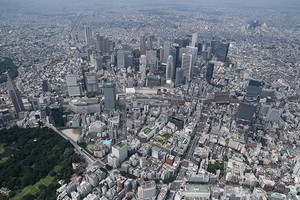THE ASAHI SHIMBUN
February 3, 2025 at 17:16 JST
The Diet's debate over making high school tuition free around the country is intensifying as the amounts and requirements to receive financial aid from local governments has led to gaps in student equity.
These disparities are a side effect of some local governments opting to provide further support to supplement the central government's income-restricted tuition assistance.
Eliminating these and implementing a uniform nationwide system would pose a challenge, however, with funding estimated at around 600 billion yen ($3.9 billion).
Tokyo Governor Yuriko Koike emphasized the central government’s role in offering free high school education during a news conference on Jan. 31.
“The central government is supposed to do it,” she said. “We are watching closely how it will handle this moving forward.”
This fiscal year, Tokyo expanded its own tuition support program.
The central government provides financial support up to 118,800 yen annually for children from households earning between 5.9 million yen and 9.1 million yen, and up to 396,000 yen annually for children from households earning less than 5.9 million yen.
The free tuition policy, initiated by the former Democratic Party of Japan administration, was revised in fiscal 2014 by the ruling coalition of the Liberal Democratic Party and junior partner, Komeito, which introduced income restrictions.
Tokyo has supplemented this with additional support, covering up to an average tuition cost of 484,000 yen for private school students in the capital.
This fiscal year, it has removed income restrictions.
Osaka Prefecture, led by Hirofumi Yoshimura of Nippon Ishin (Japan Innovation Party), has begun phasing in a more generous support system this fiscal year.
The prefecture provides up to 630,000 yen annually to private school students. If this support falls short, schools will bear additional costs starting from fiscal 2026, regardless of household income.
However, these enhanced support measures have also caused friction.
Last year, the governors of Saitama, Chiba and Kanagawa prefectures pointed out that Tokyo’s own support program has created significant disparities due to the financial situations of local governments.
Although similar support initiatives exist nationwide, the amounts and eligibility vary widely.
OUT OF THE QUESTION
“In the red again …,” murmured a 41-year-old woman from Sagamihara, Kanagawa Prefecture, as she checked her household bookkeeping.
Her family’s education expenses amount to nearly 70,000 yen a month, including 40,000 yen for her junior high school son’s cram school and additional costs such as sports club fees for her elementary school-age daughter in the fifth grade and son in the third grade.
The family’s monthly income consists of her husband’s take-home pay of about 300,000 yen from his teaching job and her own part-time earnings of 100,000 yen.
The couple feel that they cannot afford private school tuition.
Although Kanagawa Prefecture offers high school tuition assistance for families with multiple children, the mother said their income may slightly exceed the eligibility limit.
“I really feel the gap between Tokyo and here,” she said.
Her home is only about 100 meters from the Tokyo border.
“I’ve heard of people moving to Tokyo for the benefits,” the mother said. “We took out a mortgage to buy our home, so we have no choice but to stay. But if we could, I’d seriously consider moving.”
“I feel it’s unfair under the current system,” she added. “Education costs are too high and even with both parents working, we can’t keep up.”
“I want high school tuition to be free across the country,” she said.
AN APPROACHING DEADLINE
Differences in tuition support between local governments are already influencing students’ school choices, with more students in Tokyo and Osaka opting for private high schools.
A survey conducted in December by the Tokyo Junior High School Headmasters' Association showed that the percentage of third-year public junior high school students aiming to attend Tokyo metropolitan high schools had dropped to 66.97 percent, down from 71.98 percent the previous year.
This is the first time in around 30 years that the rate has fallen into the 60 percent range.
In Osaka, during last spring’s entrance exams, the percentage of students applying only to private high schools surpassed 30 percent for the first time in 20 years, while nearly half of public high schools did not reach full enrollment.
Nationwide, private school students make up around 35 percent of all high school students.
In Tokyo, the figure rises to about 60 percent. In Osaka, it stands at around 40 percent.
A Tokyo metropolitan assembly member emphasized the importance of expanding support, saying, “Private schools play a role in the public education system.”
The debate in the Diet gained momentum late last year as the minority ruling coalition, led by Prime Minister Shigeru Ishiba, and Nippon Ishin drew closer on the issue.
They agreed to reach a conclusion in mid-February, but uncertainties remain over funding and timing.
According to the education ministry, 73 percent of students receive some form of support under the current system, which also includes grant-based scholarships.
Meanwhile, the high school enrollment rate has now reached around 99 percent.
Some experts argue that the right to education should be guaranteed for all, just like compulsory education.
(This article was written by Yukihito Takahama, Chika Yamamoto, Natsuno Otahara, Daishiro Inagaki and Honomi Homma.)




















A peek through the music industry’s curtain at the producers who harnessed social media to help their idols go global.
A series based on diplomatic documents declassified by Japan’s Foreign Ministry
Here is a collection of first-hand accounts by “hibakusha” atomic bomb survivors.
Cooking experts, chefs and others involved in the field of food introduce their special recipes intertwined with their paths in life.
A series about Japanese-Americans and their memories of World War II